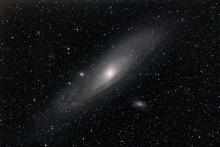Listen to today's episode of StarDate on the web the same day it airs in high-quality streaming audio without any extra ads or announcements. Choose a $8 one-month pass, or listen every day for a year for just $30.
You are here
Equal Galaxies?
The Milky Way galaxy and its nearest big neighbor, the Andromeda galaxy, are like two children on a see-saw: They’re up and down.
Both are giant spiral galaxies. Andromeda is about two-and-a-half million light-years away, in the constellation Andromeda. Under dark skies, it’s just visible as a hazy smudge of light — the farthest object that most people can see with their eyes alone.
Over the last few decades, astronomers have measured the mass of the two galaxies many times. But they keep coming up with different answers for which is the heaviest — one goes up, the other comes down. Most efforts have given the nod to Andromeda. But a few have said its the Milky Way.
The problem is, it’s hard to measure either galaxy. We’re inside the Milky Way, so we can’t see the whole thing. And even though Andromeda is quite close, it requires a high degree of precision to measure its size and mass.
A recent study, by astronomers in Australia, measured the motions of some dying stars. From those motions, the team calculated how fast a star must move to escape the galaxy. That revealed the galaxy’s total mass — all of its stars, gas, and dark matter: about 800 billion times the mass of the Sun — quite similar to the Milky Way.
The study makes some assumptions about Andromeda, and there’s some wiggle room in its numbers. But if they’re right, then the Milky Way and Andromeda are equals — neither one up or down on the galactic see-saw.
Script by Damond Benningfield





